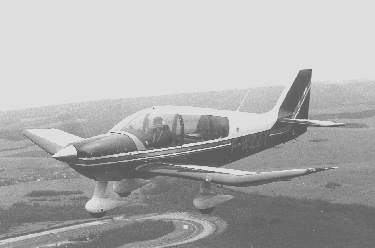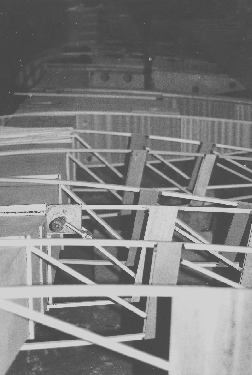
Julian Moxon/DIJON
Drive out of Dijon on the N71 and, after a few kilometres of winding road, you come to a place called Darois, where you may have to stop, or at least slow down, while an aeroplane is taxied across the road from where it was built to where it will fly.
If you are visiting Avions Robin, the second pleasure is more evocative - at least to one who spent hours of pre-teenage youth building model wooden aircraft. It is the smell of pine, mixed with glue. Oregon pine, to be precise, chosen for its specialist task by one of Robin's seasoned woodsmiths and used to build the only all-wooden touring aircraft in the world.
This year marks the 40th anniversary of Avions Robin, which, before it was taken over by Pierre Robin (now in retirement nearby), manufactured the Jodel, recognisable immediately by its distinctive dihedral wing profile.
Now, the 11-aircraft Robin range consists of metal and wooden aircraft, but it says something about the success of the original design (which has changed little since the Jodel) that 2,500 of the 3,500 aircraft manufactured since then have been wooden, with the share of 1998 production expected to be even higher, at around three-quarters of the 60 or so aircraft which Robin expects to produce (against 54 in 1997). Most of these will be destined for French aero clubs, where the type has remained popular as an easy-to-fly trainer doing much the same job for first-time fliers as the Cessna 152 has done for thousands in the USA. The DR400 is also popular in Germany, and in the UK, where, in 1996/7, the first sales for many years were made.

WOODEN PROPERTIES Why wood? Avions Robin president Jean-Paul Pellissier says: "Wood remains the best compromise between high performance and low cost. It is easy to maintain, and the aero clubs know how to repair it. Because it is lighter than metal, the aircraft performs better. It is also cheaper to manufacture than composite materials."
Pellissier admits that Robins do not thrive on being left outside to endure the elements. "They must be hangared - but what you get in return is the complete absence of corrosion, fatigue and mould. With the right care, a Robin can still be in excellent condition 25 years after it was built," he points out.
Unexpectedly, the 60-strong workforce at Darois does not consist solely of ageing artisans, who, when gone, will take irreplacerable skills with them. A tour of the different workshops reveals that the average age of the incumbents is closer to 30. "We find the people we need without difficulty," says export manager Francois Billet. "Often, they come from a background in furniture repair and, after about six months training in the ways of aircraft wood construction, they're ready to build aircraft." They do so using the original jigs to lay up and clamp the wooden components, all of which are cut and shaped in-house. The final finishing is done manually, leaving aircraft which, outwardly, are identical, but which have their own characters inherent in the tiny differences between each.

The entire aircraft is glued together, modern synthetic glues providing the necessary flexibility to allow the slight movement of the airframe during its working life. Interlocking mortise-type joints would not only be more complicated and expensive to shape, but would also tend to work loose. The aircraft is then covered in Dacron (which has replaced the original doped linen), and finished to a high standard in the paint shops. It takes around three months to build an aircraft, and the average order-to-delivery delay is between two and three months.
In the past two years, Avions Robin, which will celebrate its 40th anniversary with a fly-in to its Darois airfield, has been through something of a revolution, both in management and organisation. The end result is that Dijon is now the headquarters of Aeronautique Services, a Fr30 million ($4.7 million) company which owns not only Robin, but aerobatic aircraft manufacturer Avions Mudry, Bul Ultralight and glider manufacturer SN Centrair. The latter companies are based, respectively, in Dijon and Le Blanc, near Chateauroux.

Mudry, famous for its Cap 10 and Cap 232, went bankrupt in 1997, giving the Pellissier brothers (Jean-Paul's brother, Guy, is president of Aeronautique Services) an unmissable chance. Pellissier had already decided to get into the business through a US company, Akrotech USA, designer of the all-carbonfibre composite G202 kitplane. Akrotech USA was looking for a partner to certificate the aircraft when Avions Mudry was going bankrupt. It became clear that the Mudry and Akrotech aircraft were complementary. Pellissier then took a risk. "We signed with Akrotech before the Mudry business had been settled, so there was a possibility we would have lost Mudry and actually been in competition with them," he says.
The deal meant that Aeronautique Services was able to bring a range of aerobatic aircraft under one roof - the all-wooden side-by-side seat Cap 10, the single-seat wood/metal Cap 232 and the tandem-seat G202, now available as a complete aircraft, using carbonfibre composite parts and renamed the Cap 222.
French certification of the Cap 222 is expected around mid-year, bringing to the market a machine which Pellissier says will offer a "completely new dimension" to aerobatic competitions. An indication of how seriously the aircraft is being taken is the recent engagement of 1995 world aerobatics champion Dominique Roland as president of the Akrotech division, to help develop and market the Cap 222. "With a roll rate of 500¹/s, 180kt [330km/h] cruising speed and a 6h ferry endurance, we believe we have a winner," says Pellissier.

EARLY SALES
His predictions are backed up by the sale of seven aircraft before gaining European Joint Aviation Authorities certification, which is expected in March. The cost of the fully assembled aircraft will be $170,000, while the original G202, sold as a fast-build kit and not including engine, propeller, avionics and engine instruments, sells at $60,000. A further option is with the airframe built from the kit by Akrotech Europe, with new engine and propeller, but with painting and setting up left to the customer. This costs $145,000.
Robin introduced its first all-metal aircraft in 1980, and the series today consists of the two-seat R200; its aerobatic derivative, the R2160; and the four-seat R3180. A version of the 2160, with an enlarged canopy, was proposed to the Royal Air Force for its Bulldog replacement requirement, and is now used for demonstrations. The R200, at Fr500,000, is described by Robin as "one of the lowest-cost trainers available in its class", while the T-tail R3180, which sells for Fr980,000, remains in production, with around 50 examples having been sold to date.
The four-seat wooden aircraft for which Robin is so well known are sold in several versions, beginning with the original 90kW (120hp) DR400 Dauphin, priced at Fr710,000, and extending up through the fuel-injected Dauphin, the 120kW Regent, 135kW Regent, the Remo 180R and 200R glider tugs and, at the top of the range, the DR500 Super Regent and its fuel-injected counterpart, the President. The latter two types introduced the first major change to the original design since its debut in 1958. This centres on a wider, longer, cockpit, with space for three passengers, and allows for further room on the instrument panel to accommodate a more-comprehensive avionics fit.
For the President, four examples of which have already been sold, much attention has been paid to passenger comfort, with extra noise suppression, improved ventilation and a luxury interior. Robin says that the aircraft "-cannot be beaten" for performance, because of the lighter weight of the wooden design, claiming a 1,850km (1,000nm) range, flying at 260kt.
Robin is also working on a contract for French unmanned-air-vehicle specialist Sagem, in which it is responsible for designing and producing 35 delta-winged all-composite drones. The first two were metal, allowing the basic profile to be settled, with the remaining 33 on order being made from glassfibre composite.
NEW AIRCRAFT
Pellissier provides little indication about any new types. "We're working on improving our production methods, and we have a number of ideas that may lead to the development of new aircraft," is all he will say.
A re-organisation is under way at Dijon to better accommodate production of the Cap 222 and any new aircraft. A new static-test rig is under construction, initially to prove the airframe strength of the Cap 222, but capable also of testing aircraft "larger than the DR400", says Pellissier, a former design engineer at Dassault. In 1991 he joined Reims Aviation, leaving it in "good shape" after five years. If the activity since he joined Avions Robin is anything to go by, it will not be long before another new aircraft is taxied to Darois for its first flight.
Source: Flight International























